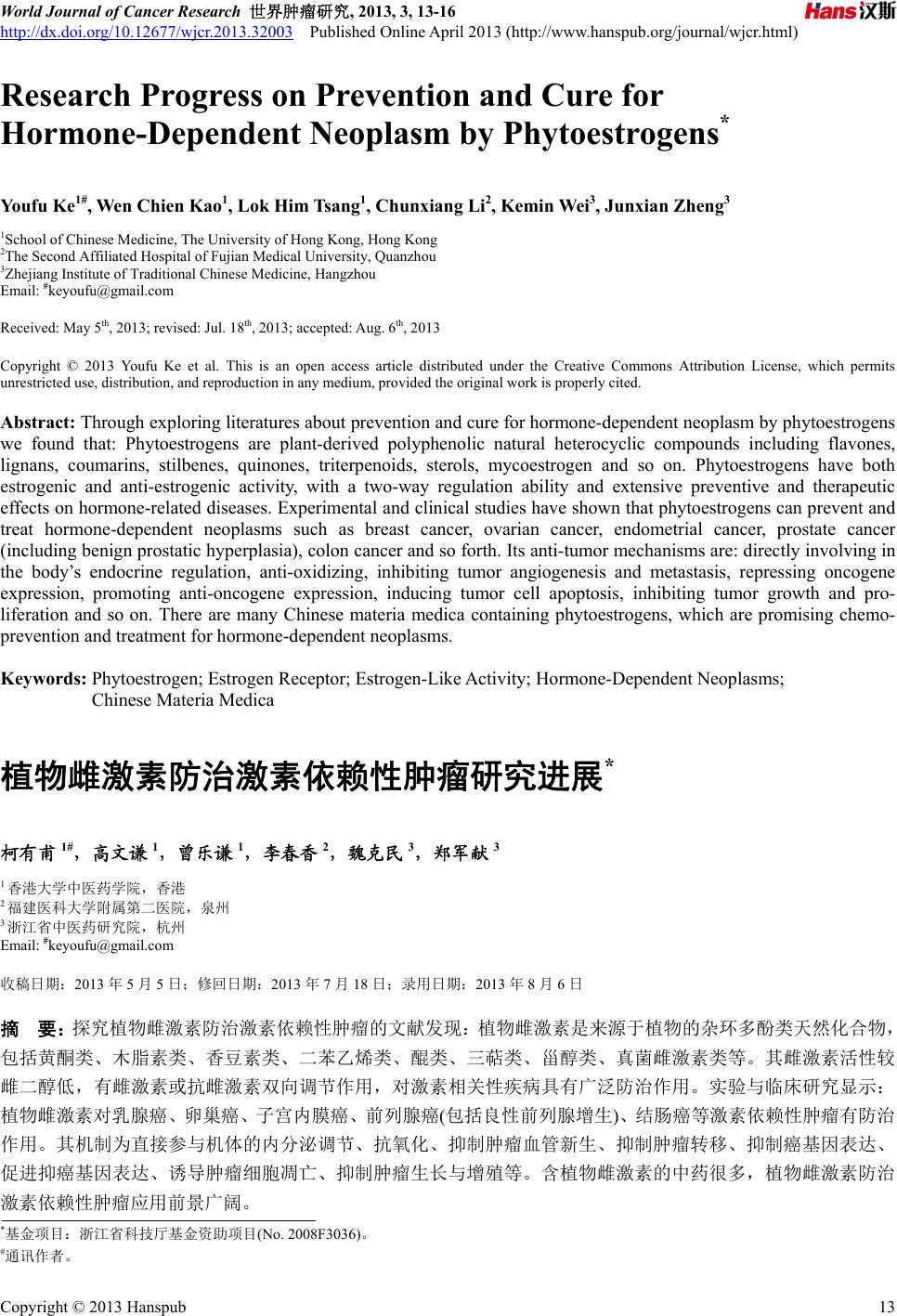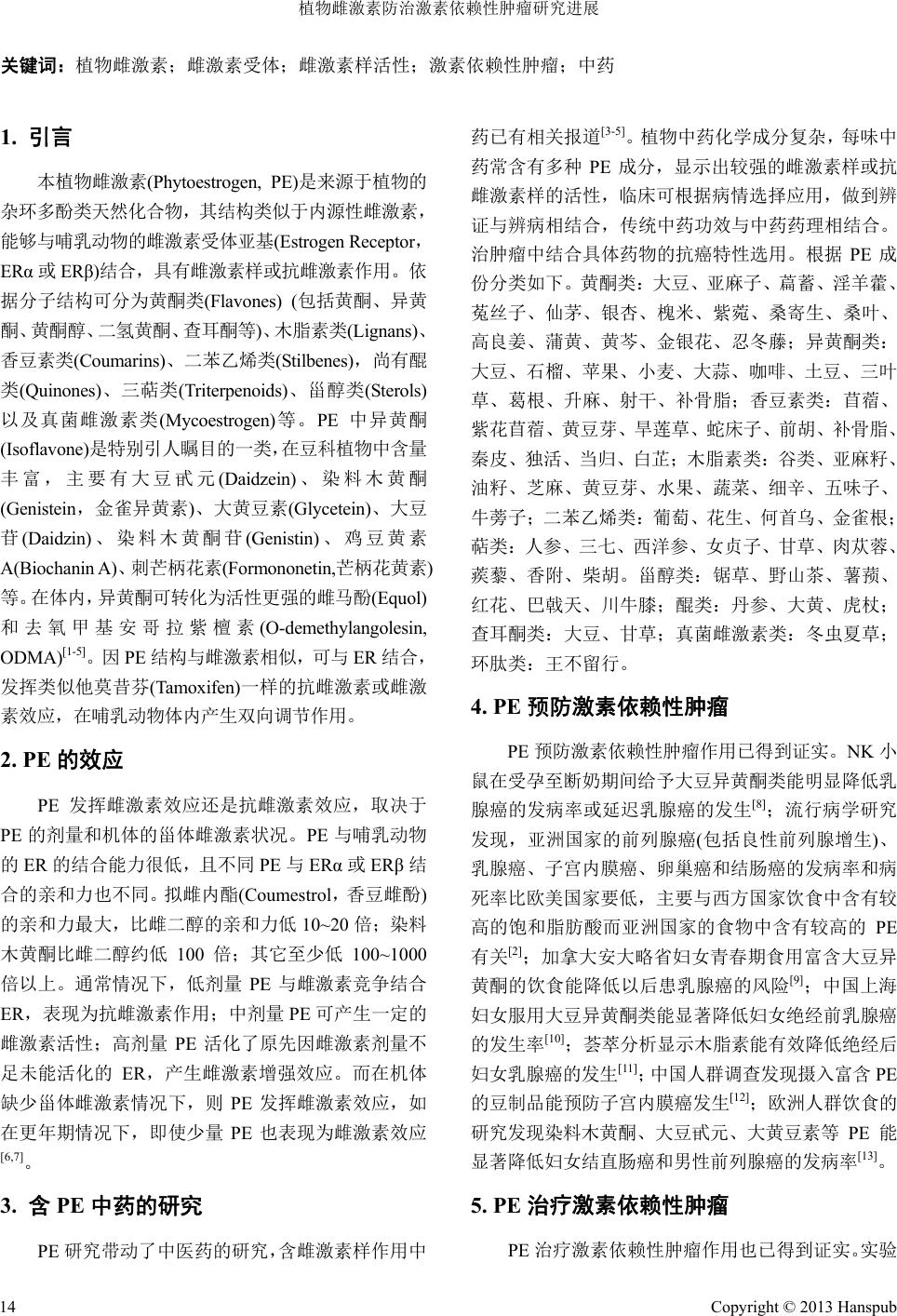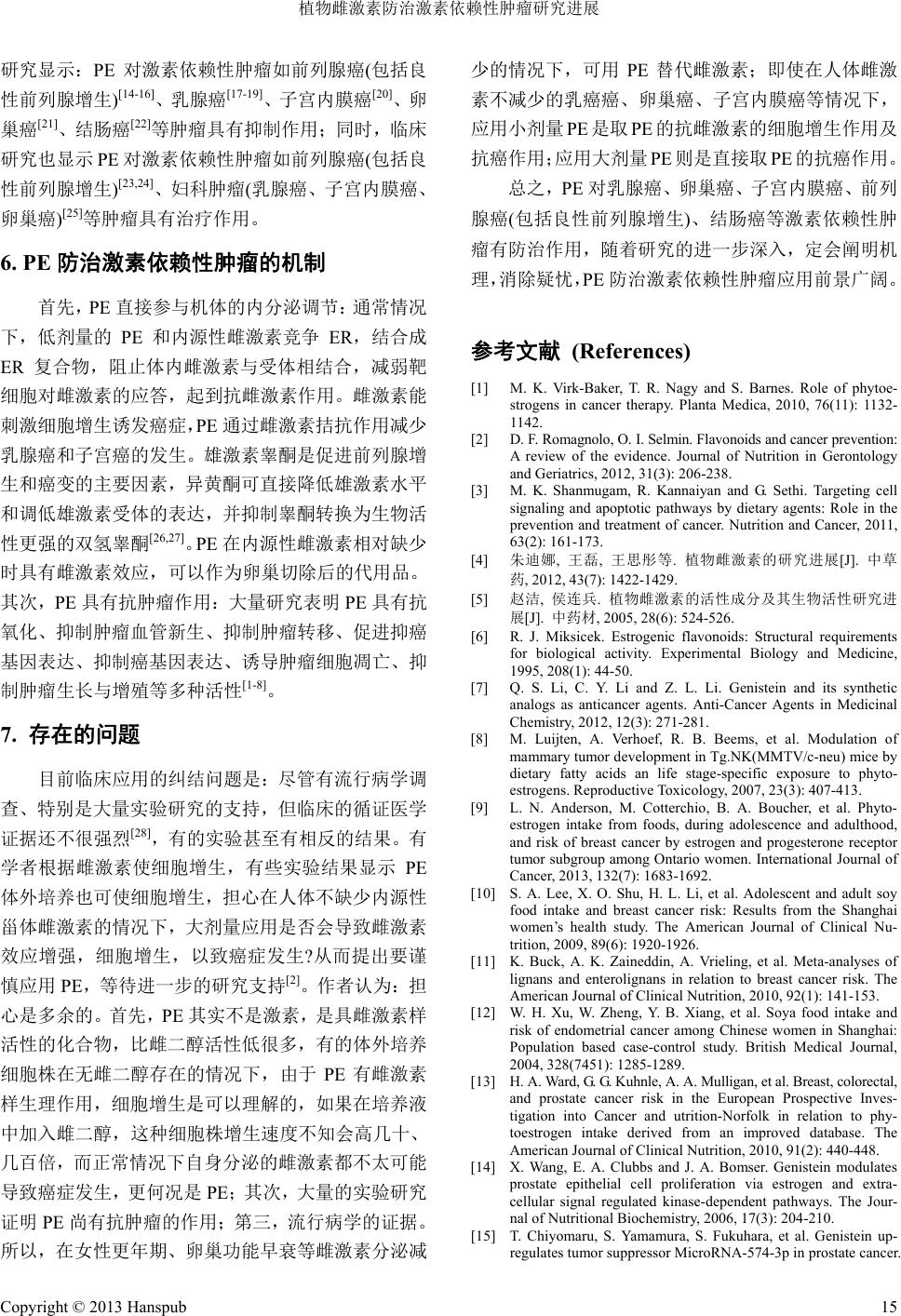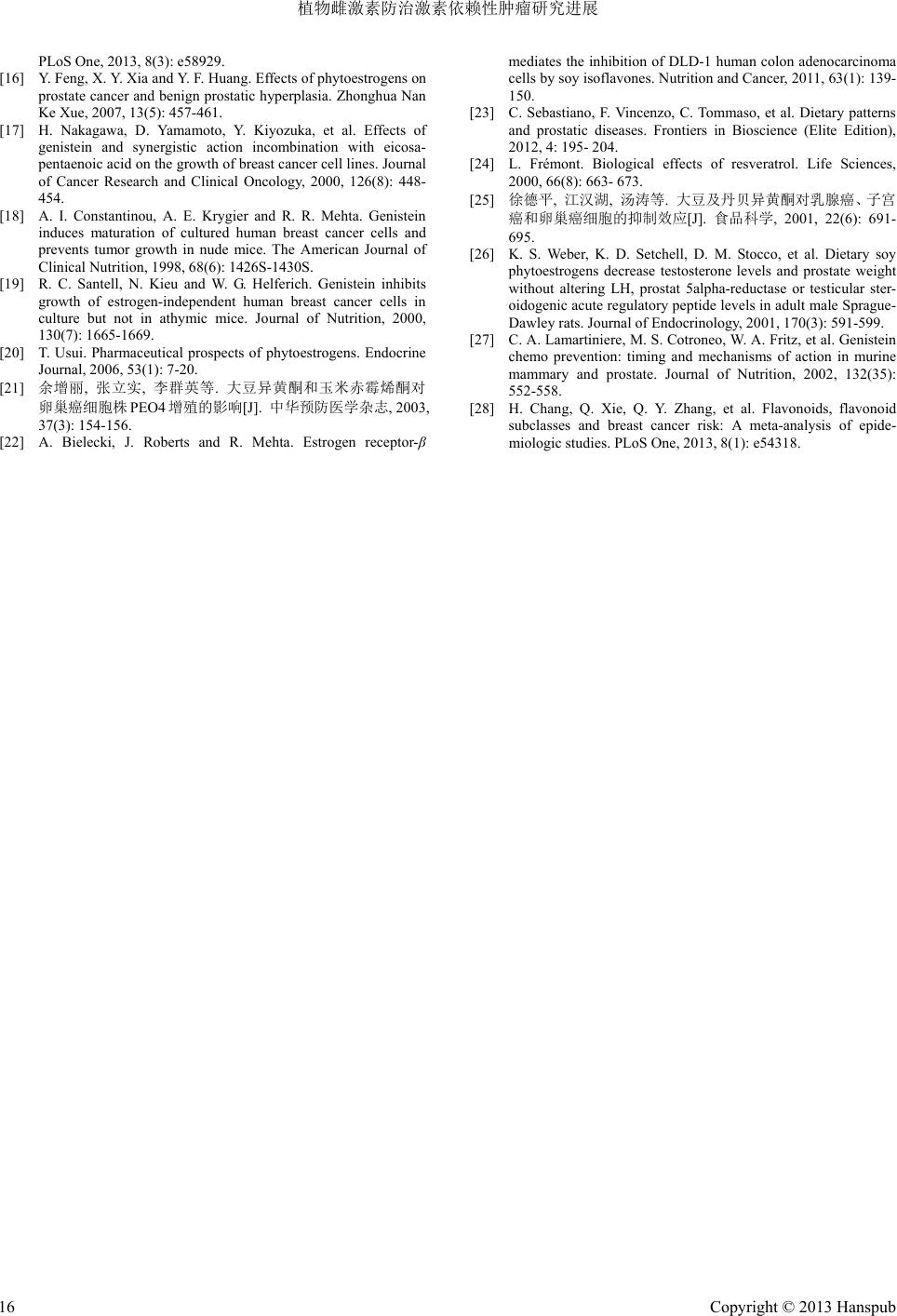 World Journal of Cancer Research 世界肿瘤研究, 2013, 3, 13-16 http://dx.doi.org/10.12677/wjcr.2013.32003 Published Online April 2013 (http://www.hanspub.org/journal/wjcr.html) Research Progress on Prevention and Cure for Hormone-Dependent Neoplasm by Phytoestrogens* Youfu Ke1#, Wen Chien Kao1, Lok Him Tsang1, Chu n xiang Li2, Kemin Wei3, Junxian Zheng3 1School of Chinese Medicine, The University of Hong Kong, Hong Kong 2The Second Affiliated Hospital of Fujian Medical University, Quanzhou 3Zhejiang Institute of Traditional Chinese Medicine, Hangzhou Email: #keyoufu@gmail.com Received: May 5th, 2013; revised: Jul. 18th, 2013; accepted: Aug. 6th, 2013 Copyright © 2013 Youfu Ke et al. This is an open access article distributed under the Creative Commons Attribution License, which permits unrestricted use, distribution, and reproduction in any medium, provided the original work is properly cited. Abstract: Through exploring literatures about prevention and cure for hormone-dependent neoplasm by phytoestrogens we found that: Phytoestrogens are plant-derived polyphenolic natural heterocyclic compounds including flavones, lignans, coumarins, stilbenes, quinones, triterpenoids, sterols, mycoestrogen and so on. Phytoestrogens have both estrogenic and anti-estrogenic activity, with a two-way regulation ability and extensive preventive and therapeutic effects on hormone-related diseases. Experimental and clinical studies have shown that phytoestrogens can prevent and treat hormone-dependent neoplasms such as breast cancer, ovarian cancer, endometrial cancer, prostate cancer (including benign prostatic hyperplasia), colon cancer and so forth. Its anti-tumor mechanisms are: directly involving in the body’s endocrine regulation, anti-oxidizing, inhibiting tumor angiogenesis and metastasis, repressing oncogene expression, promoting anti-oncogene expression, inducing tumor cell apoptosis, inhibiting tumor growth and pro- liferation and so on. There are many Chinese materia medica containing phytoestrogens, which are promising chemo- prevention and treatment for hormone-dependent neoplasms. Keywords: Phytoestrogen; Estrogen Receptor; Estrogen-Like Activity; Hormone-Dependent Neoplasms; Chinese Materia Medica 植物雌激素防治激素依赖性肿瘤研究进展* 柯有甫 1#,高文谦 1,曾乐谦 1,李春香 2,魏克民 3,郑军献 3 1香港大学中医药学院,香港 2福建医科大学附属第二医院,泉州 3浙江省中医药研究院,杭州 Email: #keyoufu@gmail.com 收稿日期:2013 年5月5日;修回日期:2013 年7月18 日;录用日期:2013 年8月6日 摘 要:探究植物雌激素防治激素依赖性肿瘤的文献发现:植物雌激素是来源于植物的杂环多酚类天然化合物, 包括黄酮类、木脂素类、香豆素类、二苯乙烯类、醌类、三萜类、甾醇类、真菌雌激素类等。其雌激素活性较 雌二醇低,有雌激素或抗雌激素双向调节作用,对激素相关性疾病具有广泛防治作用。实验与临床研究显示: 植物雌激素对乳腺癌、卵巢癌、子宫内膜癌、前列腺癌(包括良性前列腺增生)、结肠癌等激素依赖性肿瘤有防治 作用。其机制为直接参与机体的内分泌调节、抗氧化、抑制肿瘤血管新生、抑制肿瘤转移、抑制癌基因表达、 促进抑癌基因表达、诱导肿瘤细胞凋亡、抑制肿瘤生长与增殖等。含植物雌激素的中药很多,植物雌激素防治 激素依赖性肿瘤应用前景广阔。 *基金项目:浙江省科技厅基金资助项目(No. 2008F3036)。 #通讯作者。 Copyright © 2013 Hanspub 13  植物雌激素防治激素依赖性肿瘤研究进展 Copyright © 2013 Hanspub 14 关键词:植物雌激素;雌激素受体;雌激素样活性;激素依赖性肿瘤;中药 1. 引言 本植物雌激素(Phytoestrogen, PE)是来源于植物的 杂环多酚类天然化合物,其结构类似于内源性雌激素, 能够与哺乳动物的雌激素受体亚基(Estrogen Receptor, ERα或ERβ)结合,具有雌激素样或抗雌激素作用。依 据分子结构可分为黄酮类(Flavones) (包括黄酮、异黄 酮、黄酮醇、二氢黄酮、查耳酮等)、木脂素类(Lignans)、 香豆素类(Coumarins)、二苯乙烯类(Stilbenes),尚有醌 类(Quinones) 、三萜类(Triterpenoids) 、甾醇类(Sterols) 以及真菌雌激素类(Mycoestrogen)等。PE 中异黄酮 (Isoflavone)是特别引人瞩目的一类,在豆科植物中含量 丰富,主要有大豆甙元(Daidzein) 、染料木黄酮 (Genistein,金雀异黄素)、大黄豆素(Glycetein) 、大豆 苷(Daidzin) 、染料木黄酮苷(Genistin) 、鸡豆黄素 A(Biochanin A)、刺芒柄花素(Formononetin,芒柄花黄素) 等。在体内,异黄酮可转化为活性更强的雌马酚(Equol) 和去氧甲基安哥拉紫檀素(O-demethylangolesin, ODMA)[1-5]。因 PE 结构与雌激素相似,可与 ER 结合, 发挥类似他莫昔芬(Tamoxifen)一样的抗雌激素或雌激 素效应,在哺乳动物体内产生双向调节作用。 2. PE的效应 PE 发挥雌激素效应还是抗雌激素效应,取决于 PE 的剂量和机体的甾体雌激素状况。PE 与哺乳动物 的ER 的结合能力很低,且不同PE 与ERα或ERβ结 合的亲和力也不同。拟雌内酯(Coumestrol,香豆雌酚) 的亲和力最大,比雌二醇的亲和力低10~20 倍;染料 木黄酮比雌二醇约低 100 倍;其它至少低 100~1000 倍以上。通常情况下,低剂量 PE与雌激素竞争结合 ER,表现为抗雌激素作用;中剂量 PE可产生一定的 雌激素活性;高剂量 PE 活化了原先因雌激素剂量不 足未能活化的 ER,产生雌激素增强效应。而在机体 缺少甾体雌激素情况下,则 PE发挥雌激素效应,如 在更年期情况下,即使少量 PE也表现为雌激素效应 [6,7]。 3. 含PE 中药的研究 PE 研究带动了中医药的研究,含雌激素样作用中 药已有相关报道[3-5]。植物中药化学成分复杂,每味中 药常含有多种 PE成分,显示出较强的雌激素样或抗 雌激素样的活性,临床可根据病情选择应用,做到辨 证与辨病相结合,传统中药功效与中药药理相结合。 治肿瘤中结合具体药物的抗癌特性选用。根据 PE成 份分类如下。黄酮类:大豆、亚麻子、萹蓄、淫羊藿、 菟丝子、仙茅、银杏、槐米、紫菀、桑寄生、桑叶、 高良姜、蒲黄、黄芩、金银花、忍冬藤;异黄酮类: 大豆、石榴、苹果、小麦、大蒜、咖啡、土豆、三叶 草、葛根、升麻、射干、补骨脂;香豆素类:苜蓿、 紫花苜蓿、黄豆芽、旱莲草、蛇床子、前胡、补骨脂、 秦皮、独活、当归、白芷;木脂素类:谷类、亚麻籽、 油籽、芝麻、黄豆芽、水果、蔬菜、细辛、五味子、 牛蒡子;二苯乙烯类:葡萄、花生、何首乌、金雀根; 萜类:人参、三七、西洋参、女贞子、甘草、肉苁蓉、 蒺藜、香附、柴胡。甾醇类:锯草、野山茶、薯蓣、 红花、巴戟天、川牛膝;醌类:丹参、大黄、虎杖; 查耳酮类:大豆、甘草;真菌雌激素类:冬虫夏草; 环肽类:王不留行。 4. PE预防激素依赖性肿瘤 PE 预防激素依赖性肿瘤作用已得到证实。NK小 鼠在受孕至断奶期间给予大豆异黄酮类能明显降低乳 腺癌的发病率或延迟乳腺癌的发生[8];流行病学研究 发现,亚洲国家的前列腺癌(包括良性前列腺增生)、 乳腺癌、子宫内膜癌、卵巢癌和结肠癌的发病率和病 死率比欧美国家要低,主要与西方国家饮食中含有较 高的饱和脂肪酸而亚洲国家的食物中含有较高的 PE 有关[2];加拿大安大略省妇女青春期食用富含大豆异 黄酮的饮食能降低以后患乳腺癌的风险[9];中国上海 妇女服用大豆异黄酮类能显著降低妇女绝经前乳腺癌 的发生率[10];荟萃分析显示木脂素能有效降低绝经后 妇女乳腺癌的发生[11];中国人群调查发现摄入富含PE 的豆制品能预防子宫内膜癌发生[12];欧洲人群饮食的 研究发现染料木黄酮、大豆甙元、大黄豆素等 PE 能 显著降低妇女结直肠癌和男性前列腺癌的发病率[13]。 5. PE治疗激素依赖性肿瘤 PE 治疗激素依赖性肿瘤作用也已得到证实。实验  植物雌激素防治激素依赖性肿瘤研究进展 研究显示:PE 对激素依赖性肿瘤如前列腺癌(包括良 性前列腺增生)[14-16]、乳 腺癌 [17-19]、子宫内膜癌[20]、卵 巢癌[21]、结肠癌[22]等肿瘤具有抑制作用;同时,临床 研究也显示 PE 对激素依赖性肿瘤如前列腺癌(包括良 性前列腺增生)[23,24]、妇科肿瘤(乳腺癌、子宫内膜癌、 卵巢癌)[25]等肿瘤具有治疗作用。 6. PE防治激素依赖性肿瘤的机制 首先,PE直接参与机体的内分泌调节:通常情况 下,低剂量的 PE和内源性雌激素竞争ER,结合成 ER 复合物,阻止体内雌激素与受体相结合,减弱靶 细胞对雌激素的应答,起到抗雌激素作用。雌激素能 刺激细胞增生诱发癌症,PE 通过雌激素拮抗作用减少 乳腺癌和子宫癌的发生。雄激素睾酮是促进前列腺增 生和癌变的主要因素,异黄酮可直接降低雄激素水平 和调低雄激素受体的表达,并抑制睾酮转换为生物活 性更强的双氢睾酮[26,27]。PE 在内源性雌激素相对缺少 时具有雌激素效应,可以作为卵巢切除后的代用品。 其次,PE 具有抗肿瘤作用:大量研究表明PE 具有抗 氧化、抑制肿瘤血管新生、抑制肿瘤转移、促进抑癌 基因表达、抑制癌基因表达、诱导肿瘤细胞凋亡、抑 制肿瘤生长与增殖等多种活性[1-8]。 7. 存在的问题 目前临床应用的纠结问题是:尽管有流行病学调 查、特别是大量实验研究的支持,但临床的循证医学 证据还不很强烈[28],有的实验甚至有相反的结果。有 学者根据雌激素使细胞增生,有些实验结果显示 PE 体外培养也可使细胞增生,担心在人体不缺少内源性 甾体雌激素的情况下,大剂量应用是否会导致雌激素 效应增强,细胞增生,以致癌症发生?从而提出要谨 慎应用 PE,等待进一步的研究支持[2]。作者认为:担 心是多余的。首先,PE其实不是激素,是具雌激素样 活性的化合物,比雌二醇活性低很多,有的体外培养 细胞株在无雌二醇存在的情况下,由于 PE 有雌激素 样生理作用,细胞增生是可以理解的,如果在培养液 中加入雌二醇,这种细胞株增生速度不知会高几十、 几百倍,而正常情况下自身分泌的雌激素都不太可能 导致癌症发生,更何况是 PE;其次,大量的实验研究 证明 PE尚有抗肿瘤的作用;第三,流行病学的证据。 所以,在女性更年期、卵巢功能早衰等雌激素分泌减 少的情况下,可用 PE替代雌激素;即使在人体雌激 素不减少的乳癌癌、卵巢癌、子宫内膜癌等情况下, 应用小剂量 PE 是取 PE 的抗雌激素的细胞增生作用及 抗癌作用;应用大剂量 PE 则是直接取 PE 的抗癌作用。 总之,PE 对乳腺癌、卵巢癌、子宫内膜癌、前列 腺癌(包括良性前列腺增生)、结肠癌等激素依赖性肿 瘤有防治作用,随着研究的进一步深入,定会阐明机 理,消除疑忧,PE 防治激素依赖性肿瘤应用前景广阔。 参考文献 (References) [1] M. K. Virk-Baker, T. R. Nagy and S. Barnes. Role of phytoe- strogens in cancer therapy. Planta Medica, 2010, 76(11): 1132- 1142. [2] D. F. Romagnolo, O. I. Selmin. Flavonoids and cancer prevention: A review of the evidence. Journal of Nutrition in Gerontology and Geriatrics, 2012, 31(3): 206-238. [3] M. K. Shanmugam, R. Kannaiyan and G. Sethi. Targeting cell signaling and apoptotic pathways by dietary agents: Role in the prevention and treatment of cancer. Nutrition and Cancer, 2011, 63(2): 161-173. [4] 朱迪娜, 王磊, 王思彤等. 植物雌激素的研究进展[J]. 中草 药, 2012, 43(7): 1422-1429. [5] 赵洁, 侯连兵. 植物雌激素的活性成分及其生物活性研究进 展[J]. 中药材, 2005, 28(6): 524-526. [6] R. J. Miksicek. Estrogenic flavonoids: Structural requirements for biological activity. Experimental Biology and Medicine, 1995, 208(1): 44-50. [7] Q. S. Li, C. Y. Li and Z. L. Li. Genistein and its synthetic analogs as anticancer agents. Anti-Cancer Agents in Medicinal Chemistry, 2012, 12(3): 271-281. [8] M. Luijten, A. Verhoef, R. B. Beems, et al. Modulation of mammary tumor development in Tg.NK(MMTV/c-neu) mice by dietary fatty acids an life stage-specific exposure to phyto- estrogens. Reproductive Toxicology, 2007, 23(3): 407-413. [9] L. N. Anderson, M. Cotterchio, B. A. Boucher, et al. Phyto- estrogen intake from foods, during adolescence and adulthood, and risk of breast cancer by estrogen and progesterone receptor tumor subgroup among Ontario women. International Journal of Cancer, 2013, 132(7): 1683-1692. [10] S. A. Lee, X. O. Shu, H. L. Li, et al. Adolescent and adult soy food intake and breast cancer risk: Results from the Shanghai women’s health study. The American Journal of Clinical Nu- trition, 2009, 89(6): 1920-1926. [11] K. Buck, A. K. Zaineddin, A. Vrieling, et al. Meta-analyses of lignans and enterolignans in relation to breast cancer risk. The American Journal of Clinical Nutrition, 2010, 92(1): 141-153. [12] W. H. Xu, W. Zheng, Y. B. Xiang, et al. Soya food intake and risk of endometrial cancer among Chinese women in Shanghai: Population based case-control study. British Medical Journal, 2004, 328(7451): 1285-1289. [13] H. A. Ward, G. G. Kuhnle, A. A. Mulligan, et al. Breast, colorectal, and prostate cancer risk in the European Prospective Inves- tigation into Cancer and utrition-Norfolk in relation to phy- toestrogen intake derived from an improved database. The American Journal of Clinical Nutrition, 2010, 91(2): 440-448. [14] X. Wang, E. A. Clubbs and J. A. Bomser. Genistein modulates prostate epithelial cell proliferation via estrogen and extra- cellular signal regulated kinase-dependent pathways. The Jour- nal of Nutritional Biochemistry, 2006, 17(3): 204-210. [15] T. Chiyomaru, S. Yamamura, S. Fukuhara, et al. Genistein up- regulates tumor suppressor MicroRNA-574-3p in prostate cancer. Copyright © 2013 Hanspub 15  植物雌激素防治激素依赖性肿瘤研究进展 Copyright © 2013 Hanspub 16 PLoS One, 2013, 8(3): e58929. [16] Y. Feng, X. Y. Xia and Y. F. Huang. Effects of phytoestrogens on prostate cancer and benign prostatic hyperplasia. Zhonghua Nan Ke Xue, 2007, 13(5): 457-461. [17] H. Nakagawa, D. Yamamoto, Y. Kiyozuka, et al. Effects of genistein and synergistic action incombination with eicosa- pentaenoic acid on the growth of breast cancer cell lines. Journal of Cancer Research and Clinical Oncology, 2000, 126(8): 448- 454. [18] A. I. Constantinou, A. E. Krygier and R. R. Mehta. Genistein induces maturation of cultured human breast cancer cells and prevents tumor growth in nude mice. The American Journal of Clinical Nutrition, 1998, 68(6): 1426S-1430S. [19] R. C. Santell, N. Kieu and W. G. Helferich. Genistein inhibits growth of estrogen-independent human breast cancer cells in culture but not in athymic mice. Journal of Nutrition, 2000, 130(7): 1665-1669. [20] T. Usui. Pharmaceutical prospects of phytoestrogens. Endocrine Journal, 2006, 53(1): 7-20. [21] 余增丽, 张立实, 李群英等. 大豆异黄酮和玉米赤 霉烯酮对 卵巢癌细胞株 PEO4 增殖的影响[J]. 中华预防医学杂志, 2003, 37(3): 154-156. [22] A. Bielecki, J. Roberts and R. Mehta. Estrogen receptor-β mediates the inhibition of DLD-1 human colon adenocarcinoma cells by soy isoflavones. Nutrition and Cancer, 2011, 63(1): 139- 150. [23] C. Sebastiano, F. Vincenzo, C. Tommaso, et al. Dietary patterns and prostatic diseases. Frontiers in Bioscience (Elite Edition), 2012, 4: 195- 204. [24] L. Frémont. Biological effects of resveratrol. Life Sciences, 2000, 66(8): 663- 673. [25] 徐德平, 江汉湖, 汤涛等. 大豆及丹贝异黄酮对乳腺癌、子宫 癌和卵巢癌细胞的抑制效应[J]. 食品科学, 2001, 22(6): 691- 695. [26] K. S. Weber, K. D. Setchell, D. M. Stocco, et al. Dietary soy phytoestrogens decrease testosterone levels and prostate weight without altering LH, prostat 5alpha-reductase or testicular ster- oidogenic acute regulatory peptide levels in adult male Sprague- Dawley rats. Journal of Endocrinology, 2001, 170(3): 591-599. [27] C. A. Lamartiniere, M. S. Cotroneo, W. A. Fritz, et al. Genistein chemo prevention: timing and mechanisms of action in murine mammary and prostate. Journal of Nutrition, 2002, 132(35): 552-558. [28] H. Chang, Q. Xie, Q. Y. Zhang, et al. Flavonoids, flavonoid subclasses and breast cancer risk: A meta-analysis of epide- miologic studies. PLoS One, 2013, 8(1): e54318. |